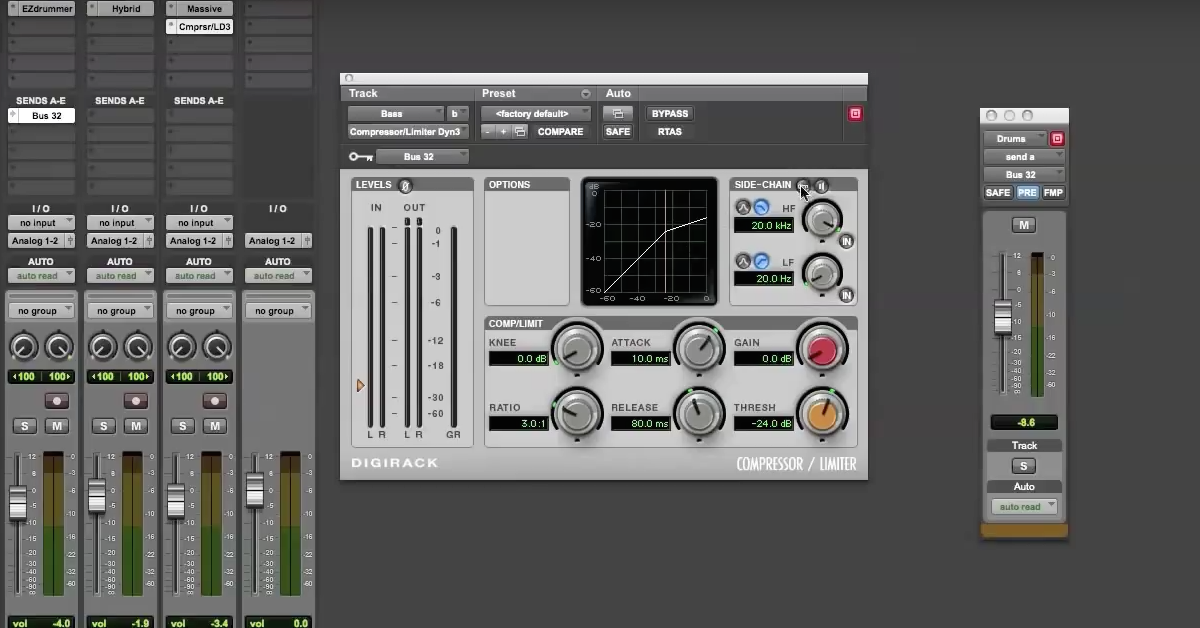Intro to Circuit Bending (+ Resources, Samples & Interview)
Article Content
The art of circuit bending is the repurposing of old toys, consumer electronics, digital synthesizers, drum machines and virtually any low voltage device for the sake of sonic exploration. The process typically involves tapping into the existing circuit boards of these devices to find unintended connections that are capable of producing unusual audio output. Potentiometers, sensors and other controllers can be placed in the signal path to provide the user with a certain degree of control and playability. Sometimes simply touching a group of solder joints with bare skin can create a tactile and intuitive interface.
Some Electronics Basics
Here are a few basics regarding electricity, some typical electronic components and their functionality.
One of the primary equations used in electronic circuit building is Ohms Law:
I = V/R
Where:
I = current
V = voltage
R = resistance
This equation can be used to design a system that produces a desired electrical outcome or can be used to predict what certain measurements should be at specific points in a circuit. A multimeter can be used to measure resistance or voltage.
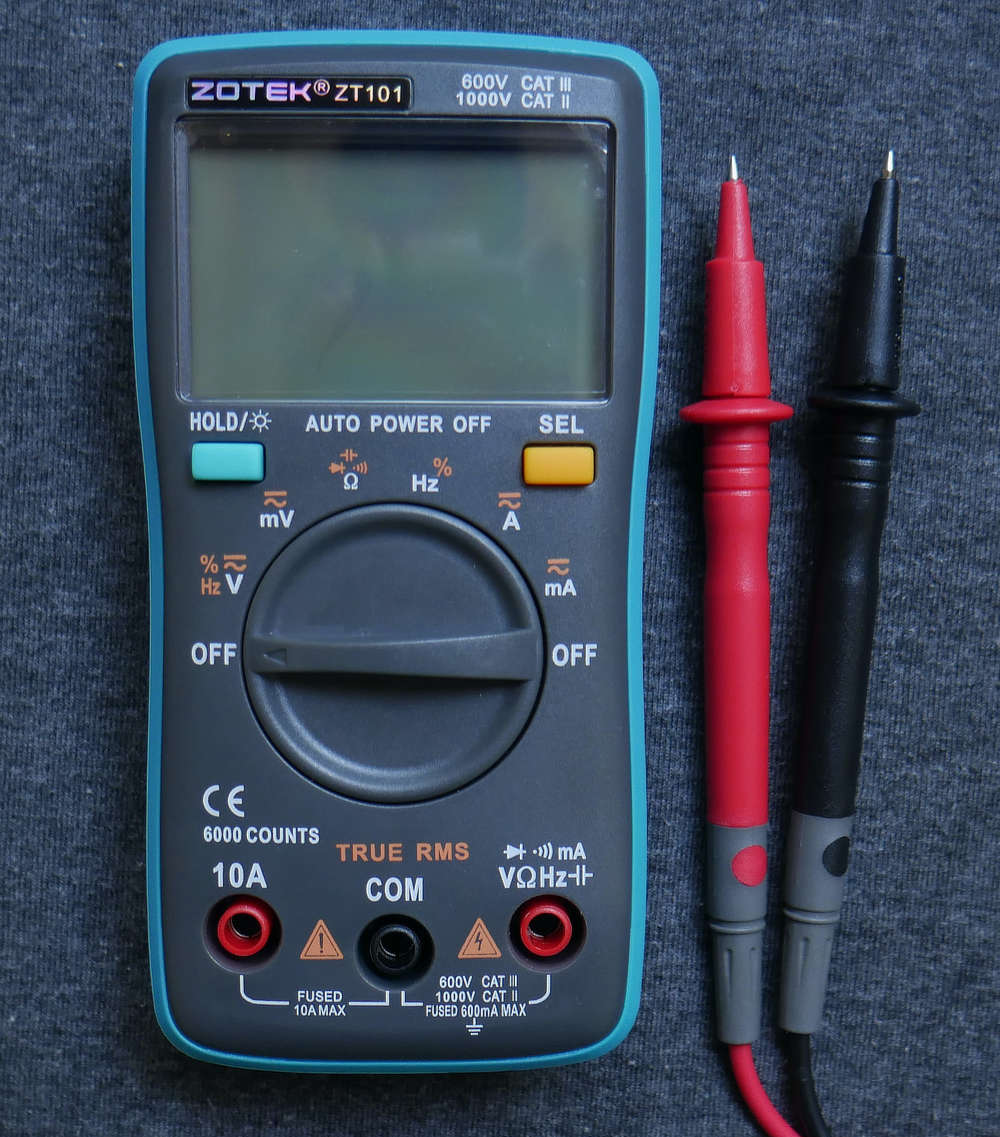
Multimeter
Resistors – as the name suggests, resist the flow of current through a circuit. The higher the resistance the lower the current, all other things being equal. The degree of resistance is measured in Ohms and is typically color-coded.
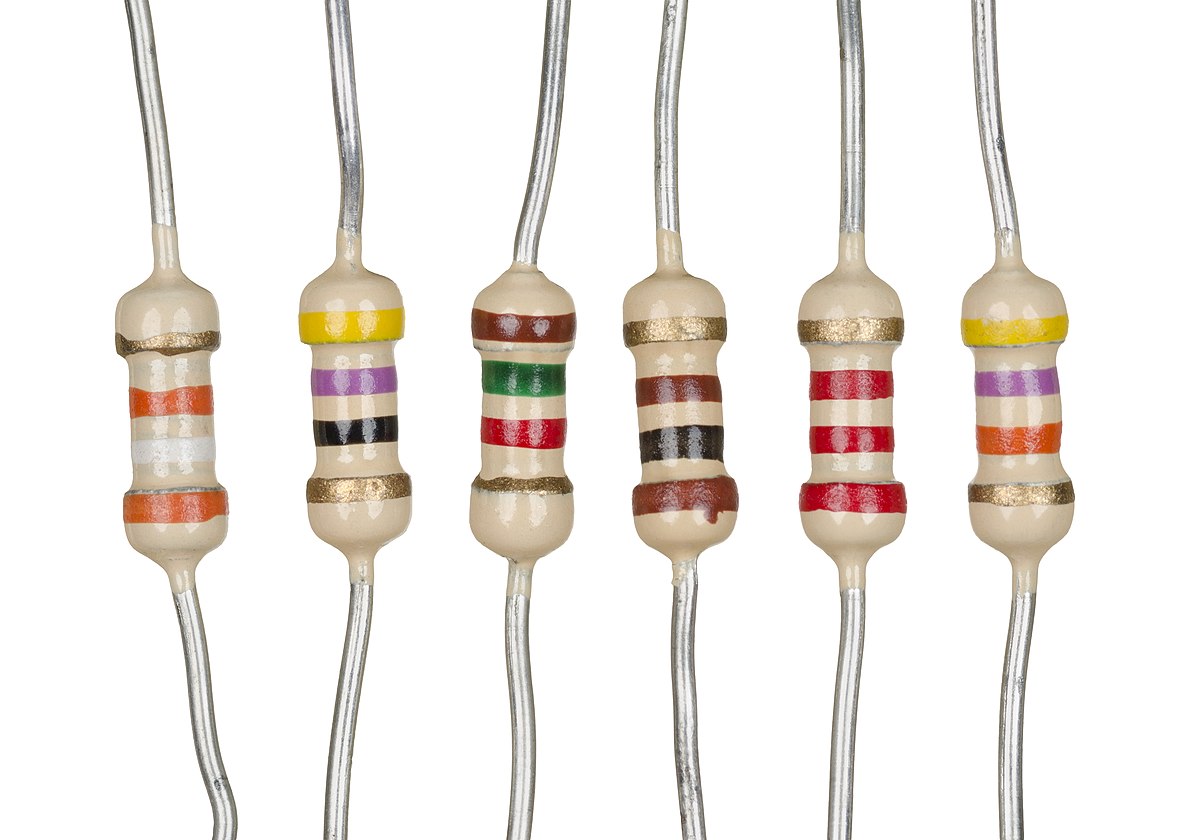
Resistors
Potentiometers – are variable resistors usually controlled by a knob or slider.
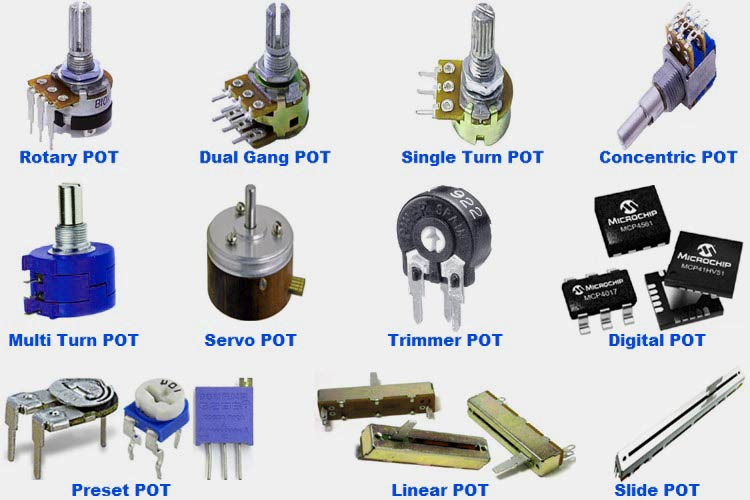
Potentiometers
Capacitors – these are components that temporarily store and release electrical charges. They are measured in farads.
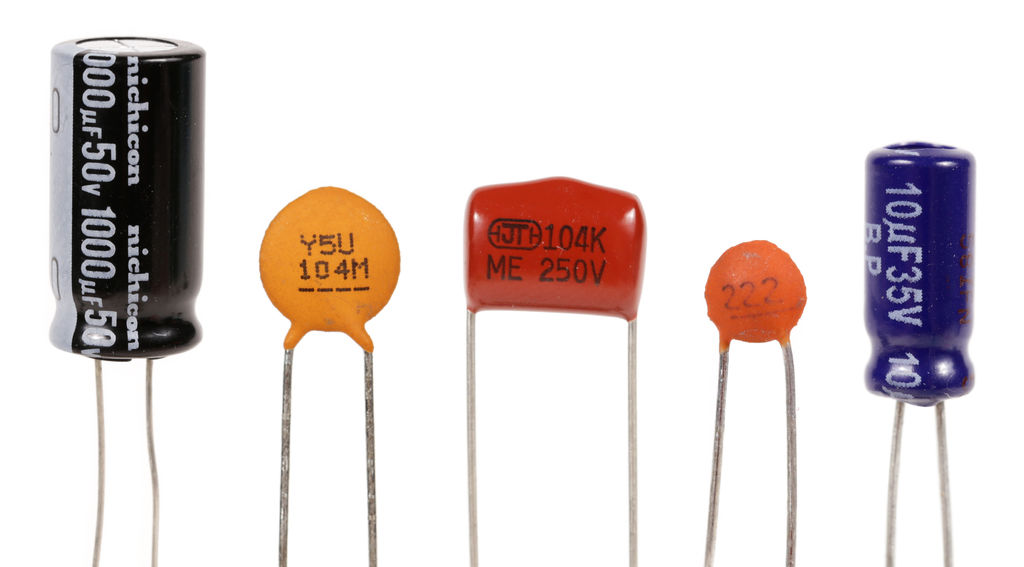
Capacitors
Transistors – are used to amplify and switch electronic signals.
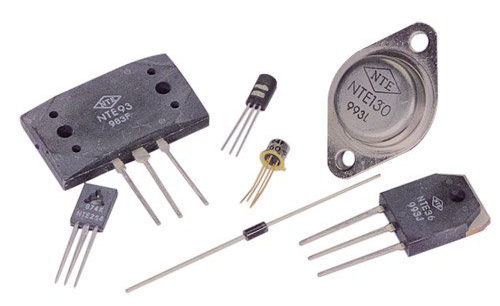
Transistors
Diodes – allow electricity to be conducted in just one direction.
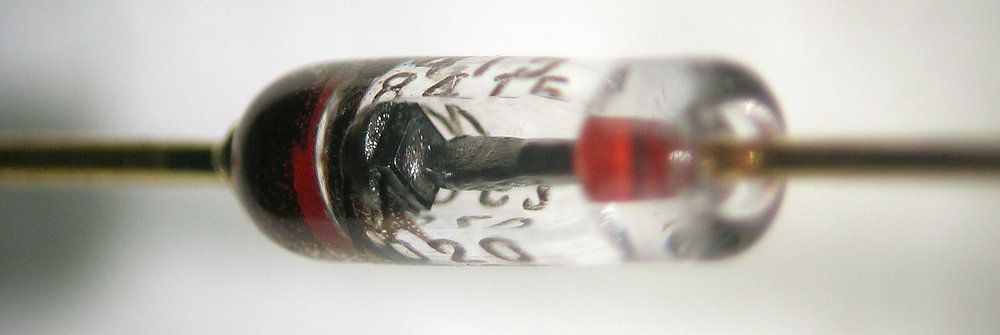
Diode
Integrated Circuits (IC) – can be designed for a number functions such as timing, amplification and signal conversion (analog/digital).
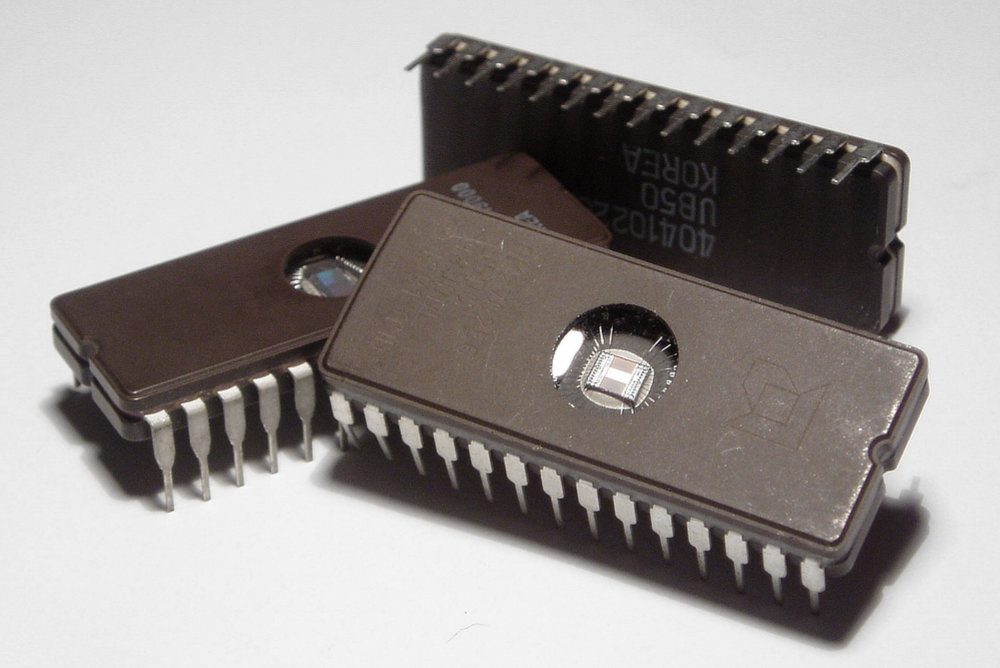
Integrated Circuits
Sensors – are components that use some external stimulus such as light, temperature or pressure to produce an analogous change in voltage. A photocell is a type of sensor that reacts to light.

Sensors
Switches – allow a signal to pass or not through a system. They can also change the routing of a signal.
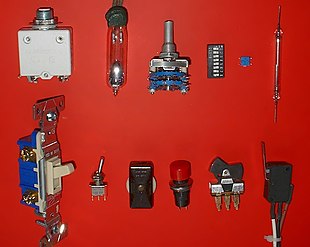
Switches
Piezo disc – this is a sensor that responds to pressure and converts it to an electrical charge. Ceramic piezo discs also used as tiny speakers.
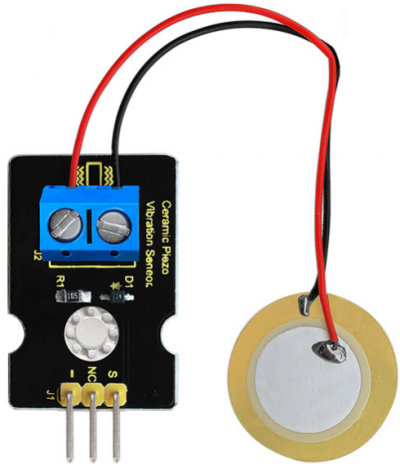
Piezo disc
These are some basic components used in electronic circuits but there are many varieties of each and others not mentioned as well. In terms of circuit bending, the key is to find the audio output of a circuit. Looking at the circuit board, you should see an output jack or perhaps a little speaker or piezo disc that facilitates the audio output of the system. The surprising thing about circuit bending a device is that if you connect the audio output to a larger full-range system and amplify it you may find the signal to be incredibly rich with frequencies present that the original device could not reproduce. When you start to re-route the signal flow in the circuit, either with your bare hands (only bend low voltage DC circuits — avoid anything that plugs into the wall) or with simple alligator clipped leads, the results can be astounding.
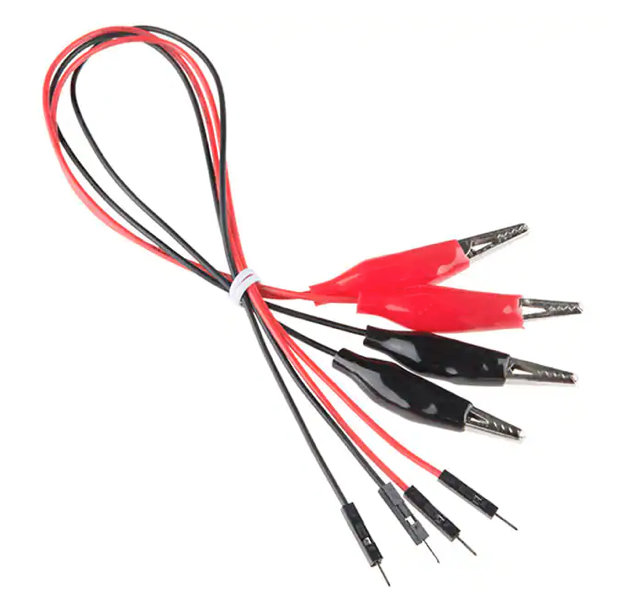
Alligator clipped leads
The Human Resistor
Several years ago I came across the book Handmade Electronic Music: The Art of Hardware Hacking (2nd Edition) by Nicholas Collins in a hacking workshop in Santa Fe, NM. This is an excellent book for those that know very little about electronics but are curious and enjoy taking things apart. It’s a great overview in general and has a side benefit of preventing possible electrocution. Below is an image of a Frankensteinian circuit-bent piece I made at the time that is played by directly touching the circuit boards or the copper pipes I attached. It includes circuit boards from an answering machine, a toy keyboard and an intercom. I called it the Human Resistor and performed on it several times.
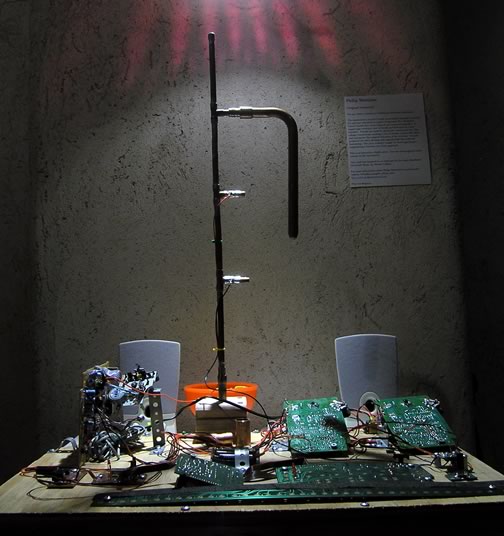
It is an understatement to say that dedicated circuit benders are a strange group. They can be found rummaging through Goodwill and Salvation Army caches of discarded toys, mistreated devices and the remnants of obsolete technology. They have studios that look like mad scientist laboratories or Emmett’s Fix-it Shop (from The Andy Griffith show). They have a natural curiosity and the desire to discover new sounds and embrace serendipity.
My personal investigations into the genre — although fruitful — were short-lived. It was not until I met Jeff Boynton that I realized that circuit bending could be elevated to the virtuosic level. Jeff is a classically trained cellist, keyboardist and arranger that toured several years with Wazmo Nariz in the late ’70s and early ’80s. He began circuit bending in 2004 and we first met around 2013, by which time he had created an astounding array of custom circuit bent instruments. For each device, he had detailed documentation of every conceivable point-to-point connection in the circuit board to be bent, with descriptions of the sonic effects to be expected (or unexpected). This was just the kind of mania that appealed to my artistic sensibility, so I immediately suggested we form a group, and TriAngular Bent was born. The third member is the great Don Preston, founding member of Frank Zappa’s Mothers of Invention. Below is a link to our eponymous release. Read the interview with Jeff at the end of this article.
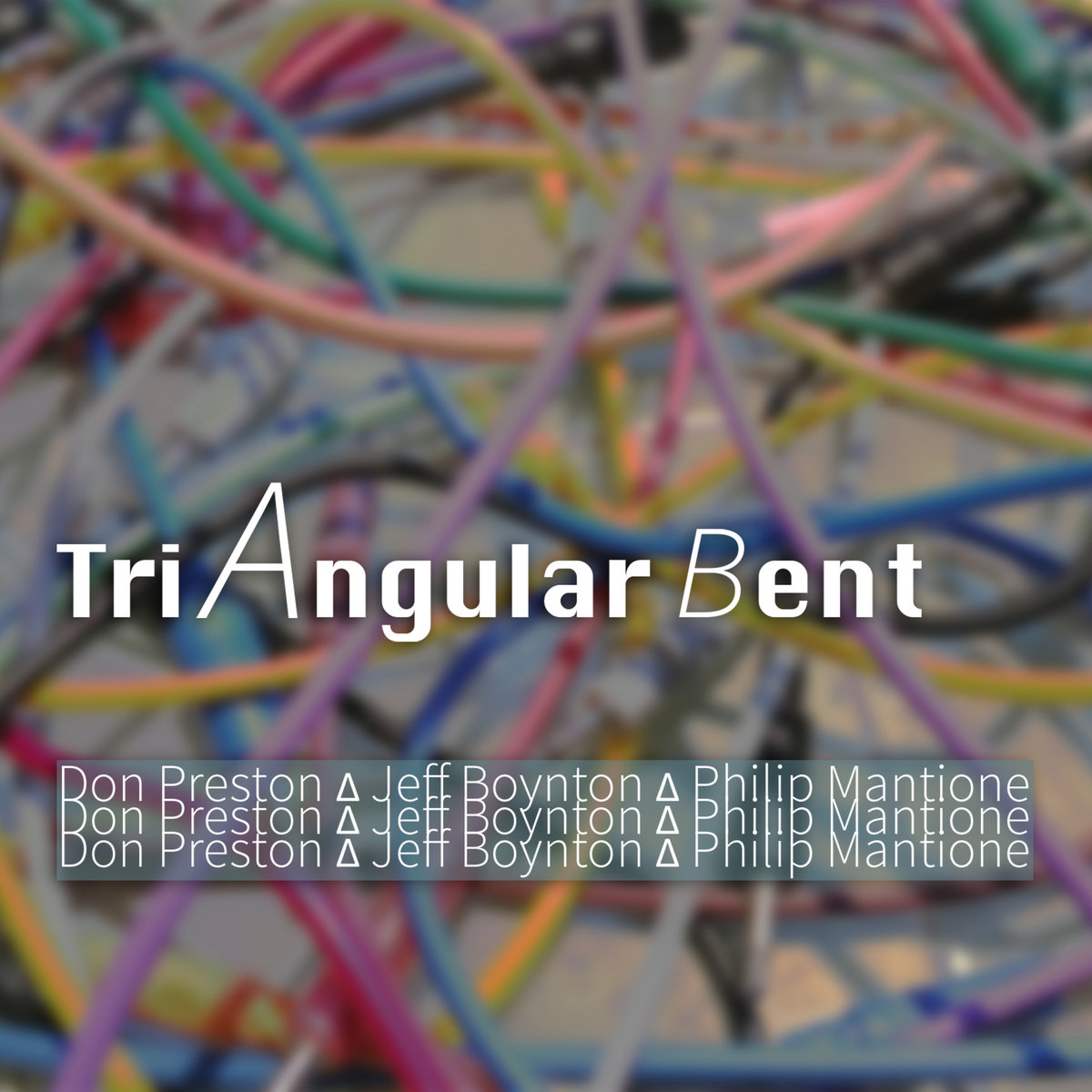
Resources
Below are a few helpful resources to learn more about circuit bending and how to get started.
Books
- Handmade Electronic Music: The Art of Hardware Hacking 2nd Edition by Nicholas Collin
- Circuit-Bending: Build Your Own Alien Instruments (ExtremeTech) 1st Edition by Reed Ghazala
Articles
- Circuit-Bend Electronic Toys Into Sonic Monsters!
- 21 DIY Kit Sources for Pro Audio, Synth Modules & Instruments
(This is one of my past articles that includes some helpful information on soldering and tools of the trade.)
Sound Libraries
There are several circuit-bent sample libraries available if you are curious about some of these sounds:
While these sample libraries are plentiful, it should be emphasized that half the fun and satisfaction comes from bending your own circuits. It is truly magical the first time a dissected device begins to speak, and it’s astounding how fast you can intuitively begin to control and play it like an instrument. If you know nothing about electronics but have the spirit of experimentation, you have everything you need to begin annoying your neighbors, friends and family in delightful ways. But in the interest of caution, I highly recommend you stick with low voltage, battery-powered devices. Death has a way of ruining an otherwise great jam.
Interview With Jeff Boynton
Jeff Boynton is a Los Angeles-based artist who has been creating and performing on custom bent devices for close to 20 years. He is a classically trained cellist, keyboardist and arranger and has performed with Wazmo Nariz, Circuitry and Poetry, Igor Amokian and TriAngular Bent among others. More information can be found at BentCity.com.
PM: Can you provide a little context on your life as a musician and how you came to circuit bending?
JB: In 1964, when I was 8 years old, there were vinyl LPs in our home that had a big impact on me as a musician/artist. One was “A Child’s Introduction to the Orchestra.” It was corny but good. Each instrument had a name (Antoinette the Clarinet, Lucy Lynn the Violin, etc.); I heard “Mellow Fellow, the Cello.” I immediately asked my parents to get me a cello and find me a teacher.
The other LP was “Columbia-Princeton Electronic Music Center,” in particular this spectacular opening track, “Stereo Electronic Music #1” by Bülent Arel.
I was blown away by the sounds, which inspired repeated listening. I didn’t think of it as music at first, it was just cool sounds. However, I began to “get it” as music the more I listened. I still find it to be fresh, original, colorful, chilling and emotional to this day. In fact, I’m listening to it right now. It wasn’t until 1975, when I was attending Northern Illinois University, that I realized they offered an electronic music class. I immediately thought of this record and a light switch went off. Soon, I was in the electronic music labs after hours creating musique concrète on reel-to-reel tape decks, long after the Music Department building was locked up for the night. I was hooked. In the meantime, I was playing cello in the NIU orchestra, where I was playing mostly standard classical repertoire. I never stopped loving that music, despite my discovery of and participation in experimental electronic music. I dropped out of school in 1978 to join Wazmo Nariz, a Chicago-based New Wave band that, by total coincidence, was formed by someone in the electronic music class I mentioned, Larry Grennan, AKA Wazmo Nariz. The music was pretty out there, and in the spirit of the times, quite unique and original. Our heroes were Devo, Talking Heads, Ian Dury and the Blockheads and other artists who didn’t sound like anyone else. We were signed to I.R.S./Illegal records in 1979, and toured in support of the Police, XTC, and opened for Devo, the B-52s, The Motels and others when they passed through Chicago. I was the keyboardist, and my rig consisted of a Fender Rhodes 73, Clavinet C and Minimoog D synth. Here’s what I consider a quintessential Wazmo song:
The drummer, Bruce Zelesnik, and I used to do a lot of experimentation as poor 20-something musicians, and we used what limited technology we had to do some really good stuff. I’d been using 2 cassette decks to do down and dirty “multitracking;” recording a track on cassette, playing it back through a mixer while playing something on along with it, building up tracks (and tape hiss).
In the intervening years between these times and the beginnings of what would lead to my involvement in circuit bending, I had put together a MIDI studio (80s/90s). I created a lot of virtual instrumental and orchestral recordings in those days.
In 1992/93, I was hired to compose music for the Bolshoi Circus of Moscow’s 1993 tour of Japan. A lot of what I created for this show was orchestral in nature but written within the capabilities of the physical instruments.
By 2002 when I began dating my future wife, Mona Jean Cedar, I was not involved in music or art of any kind. She told me she wanted to collaborate; I knew that inactivity would be coming to an end. She had been dancing with postmodern choreographer Rudy Perez, a protégé of Merce Cunningham, who was the romantic partner of John Cage. I decided I was going to approach our collaboration from the experimental angle as a result. I got a ProTools rig in 2003 for the purpose of creating musique concrète digitally.
I created music for several of Mr. Perez’ performance pieces. I started to think about collaborations with Mona, who composes poetry in ASL (American Sign Language) and incorporates ASL in her choreography.
I thought it would be interesting if I could have her motions and signing control sound somehow. As I researched this, it became obvious I’d need to learn electronics, which was not going to happen. I started googling “DIY electronic musical instruments,” and it was then I stumbled upon this interview with Reed Ghazala, the “Father of Circuit Bending.”
A big light switch went off in my head, and I thought “this is something I, or anyone, can do.” I immediately went down to Radio Shack and bought the basics to get started, mainly test leads. Within 30 minutes of having read the article, I was circuit bending. This was February 2004. By November, I had built 11 circuit-bent instruments, all of which perished in our November 21 house fire. Earlier that same day was the debut of the circuit bending marching band Mona and I created called “The Highland Park Thursday Evening Gentlemen’s Society Circuit Bending Marching Band and Ladies Auxiliary” or HPTEGSCBMBLA.
Our performance collaboration came to be known as “Circuitry and Poetry.”
Eventually, because I have pursued circuit bending passionately for 17 years, I have learned quite a bit about electronics as well as writing code for Arduino. I have added microcontrollers and my own circuitry to my instruments and have devised ways for Mona to trigger circuit bent sounds. For example, one of my interfaces involves having her wear strings of LEDs on her costume. She then moves in front of a video camera, which is connected to a monitor. An interface I designed rests on the monitor. It has an array of light-dependent resistors (LDRs for short, also known as photoresistors) arranged in a 7×7 array evenly around the monitor screen. Each LDR plays one of 49 notes on a circuit-bent keyboard, so when the image of one of the LEDs on the costume passes under the LDR, its resistance lowers and it plays that note.
Another interface employs a circuit that allows sound to trigger bent instruments. Mona has triggered my instruments by tap dancing.
Another example of using motion to control my instruments employs infrared rangefinders. I will have a number of instruments that output a constant stream of sound, like ambient sleep machines. Each is plugged into the “brain,” which senses the distance an object or human body/hand is from each rangefinder. The closer the object is, the louder the instrument it is controlling.
The same circuit that allows tap dancing to trigger sounds described above can be combined with this interface, so both it and the rangefinders combine to control the amplitude of each signal.
PM: Do you think there is something in your personality or the way you approach music in general that aligns well with the process of circuit bending?
JB: I think I share an aspect of everybody’s personality, in that to varying extents we all feel a need to impose order on a chaotic world. The appeal of circuit bending to me is that it’s like putting a stick into a vat of water with a layer of sediment on the bottom. You stir it to create chaos (an analog of poking around a circuit with test leads), and as the sediment settles, you filter out what you like (an analog of taking notes of what you discover as a result of poking around and noting your favorites. I sometimes use a 4-star rating system). The stirring up of chaos is an idea generator. I consider it a composing process. The instrument may come up with a phrase or soundscape, but it is you who poked and prodded it to do so, and these ideas would not have occurred otherwise. Occasionally, these instruments will create a phrase or start “self-composing,” and I will transcribe these into standard music notation for conventional instruments. For example, there is this toy by Fisher-Price I bent called the Baby Smartronics Animal Quartet. It has 4 songs: “When The Saints Go Marching In,” “Oh Susanna,” “Rockin’ Robin,” and “Mexican Hat Dance.” When it is circuit bent, it grabs snippets of these songs and combines them in surprising ways that loop. In one case, I used this loop as a one-bar ostinato and added a piano track to it. The odd looped phrase it creates is something I would never come up with in my head, but it lends itself to having many chords superimposed on it. Here is the track I created, based on an idea that I forced the instrument to come up with.
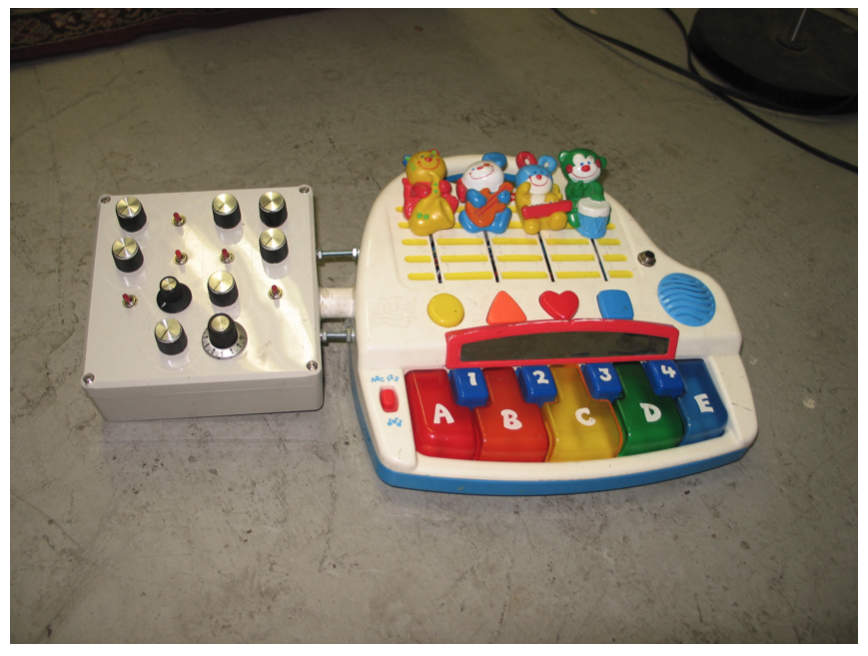
PM: I’ve not seen anyone else document all the possible connection points and combinations in a circuit board the way you do. What is your process when starting a new project?
In some cases, when the circuit is very simple, I just solder components to the circuit board as I go, and take a photo of that. Many circuits are quite complex and have many connection points, or “nodes.” In such cases, I take a photo of the circuit board and open it in Photoshop. I’ll assign numbers to each node and follow the traceback, and x out any other nodes in that trace so I don’t test them redundantly. Here is an example of a circuit that has been numbered in this way:
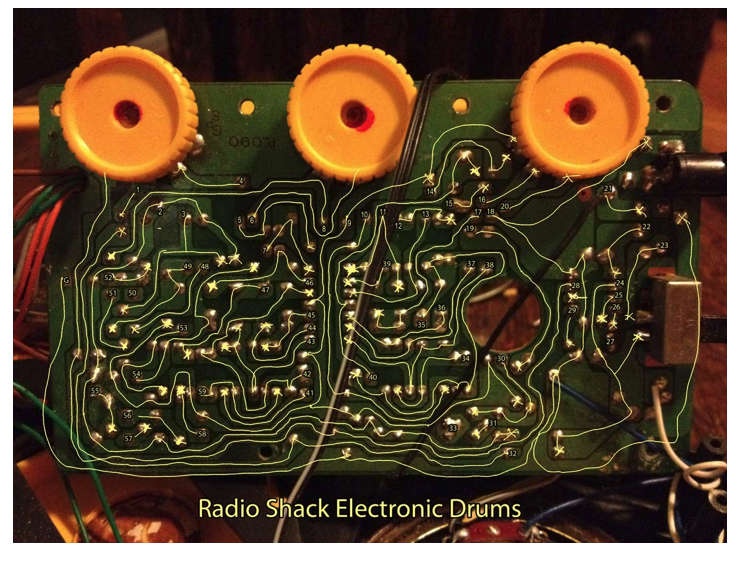
I would then test all possible combinations by holding a screwdriver in each hand as I did with this circuit, or by using 2 test leads with a 100-ohm resistor in between so as not to be creating dead shorts which can kill the circuit. The reason I used 2 handheld screwdrivers in the circuit above is that I already knew it was very responsive to body contact, meaning that you are essentially inserting your entire body into the circuit when you touch any 2 points with the screwdrivers. This circuit really sings because of the feedback that is induced by “inserting yourself” into it. My system for testing is to test point 1 to point 2, 3, 4, etc. through 59 in the case of the above circuit. Then I test 2 to 3, 4, 5, etc. through 59. I take notes of each interesting bend that I find and I describe it i.e. “fluttering noise.” If it seems redundant, I’ll write “compare,” and on the second run-through of testing, I eliminate bends that are duplicates, close to being a duplicate, or not that interesting.
PM: What are some examples of your favorite bends?
JB: The Casio MT-540, manufactured circa 1980. You can plug an external audio signal like a miked live drummer or a drum machine into it, and when you pass your hand under a bar that generates infrared light, the triggers generated by that external signal will play notes on the keyboard. This is the core of my circuit bending rig. I call it the The Über 540. It creates amazing soundscapes, and after many years, I still find new things. It’s really a mystery what’s going on under the hood. Much of circuit bending is about what results from poking around without any way of really knowing why it does what it does. These instruments can be truly unconventional in this way. A synthesizer will have specific labels on the controls indicating function i.e. “filter cutoff,” “attack time,” “resonance,” etc. Often in circuit bending, you may have something like “master pitch,” but other times a switch activates a short circuit and produces results that you have no way of explaining or even understanding. I just assign these “bend numbers.”
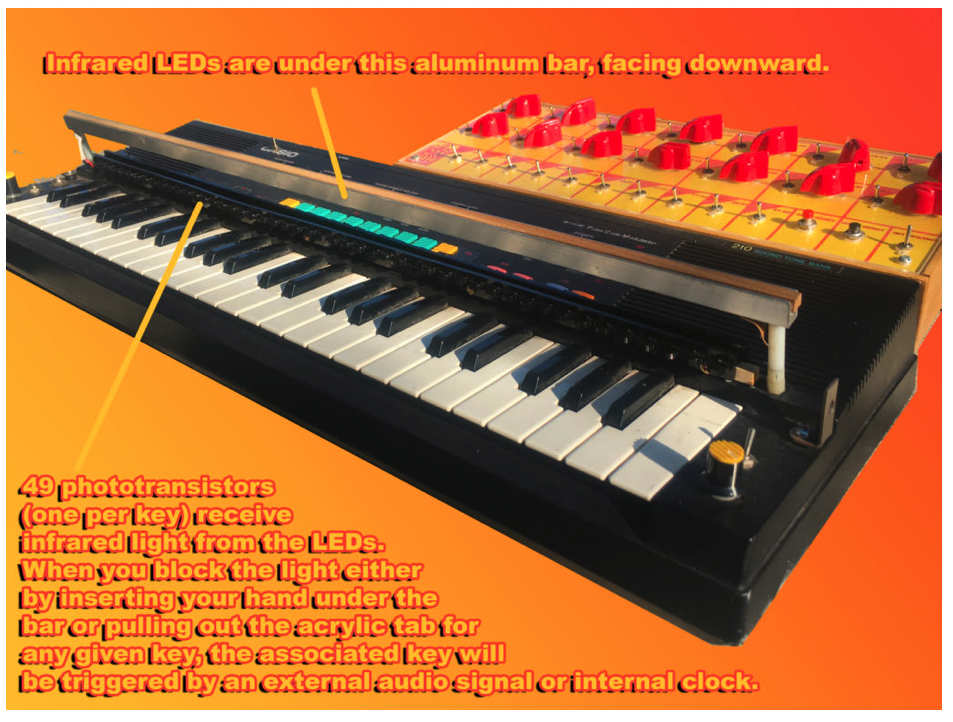
Another favorite is the Alesis SR-16 drum machine. I call my bent one the “Sweet SR-16.” Almost every bend sounds great on this one.
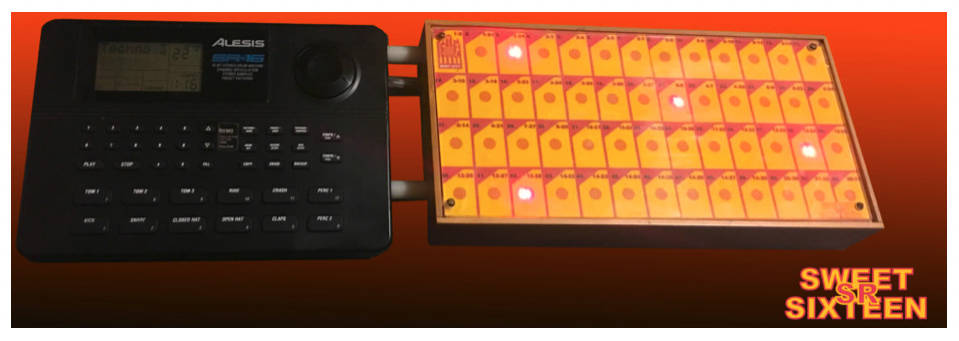
PM: Are there certain components in a circuit that are more likely to yield interesting results?
JB: It depends on the device. More advanced circuits may have sound ROM chips on them — often these are 40-pin ICs, like the 2 vertical ones on the left here:
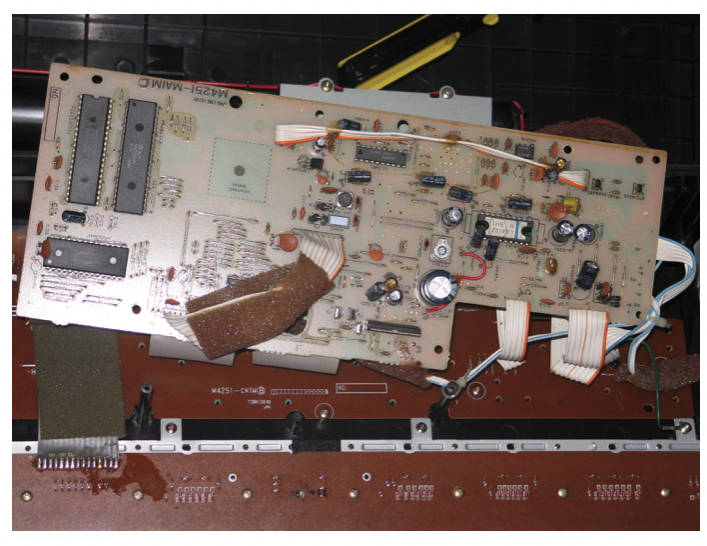
“Rerouting” the electrons in these chips by shorting various pins to each other can produce astounding results. In this case (a Casio MT-540 keyboard), I like to insert capacitors of various values in between 2 pins which are interesting when directly shorted. This can add even more variations to a given “bend.”
Often I like to touch the circuit with my fingers, sometime lightly moistened for conductivity. This can be an easy way to find the “pitch resistor” if the device has one. This is what holds the device at its “normal” speed and pitch. You can do something like replace that resistor with a pot (potentiometer) to make the pitch variable. It behaves like speeding up/slowing down a tape recorder.
PM: Have you successfully combined cello with bent circuit instruments?
JB: In 2006, after a hiatus of many years, I purchased a cello and began playing again. Now when I do solo circuit bending performances, I play cello along with circuit bending. This is a sort of “full circle” going back to those 2 vinyl LPs I mentioned at the outset of this response.
PM: Are there any resources not mentioned above that you have found particularly useful?
JB: Yes.
TableHooters is a site that features work by a German guy who has really dug into the history and inner workings of popular circuit bending targets and many keyboards.
Reed Ghazala’s website — the guy that started it all!
Tim Kaiser’s website is just plain inspiring. Amazing builder and good friend.
PM: What would you say is the necessary skill set for those who want to get started?
JB: Mostly curiosity. You might want to avoid connecting the power parts of the circuits to more delicate ones, but the point is, if you go to a thrift store and spend a few bucks on a toy, it’s not a big risk if you kill it, unless of course its primary value is as a circuit bending target. I can tell you, this is a heartbreak I’ve felt often.
If you want to actually build something, you’ll need to learn how to solder. I can say with certainty though that when I began circuit bending, I had no skill set whatsoever, so I guess my answer to the question is pretty much “no.” You need no skill set to start, but you will acquire skills as you get deeper into it.
PM: I know you also accept commissions to create instruments for others. How does that usually work? Do people send you devices to bend?
JB: I don’t like to bend other people’s devices with which I’m not familiar. I had an experience with something that I had heard was very sensitive and easy to kill, but I’d always wanted to bend one. It was true, it was easy to kill and one dropped screwdriver did it in. I had to replace it. I have successfully bent things given to me that I didn’t have experience with though, like this Casio digital guitar:
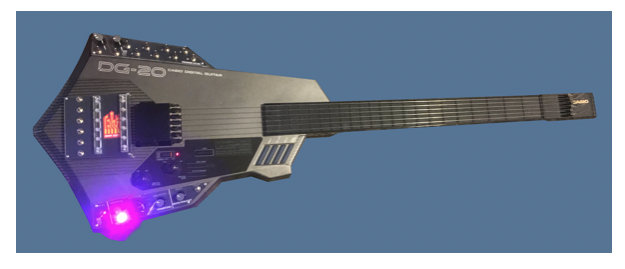
Often, I just build something as a commission from my own stock of unbent devices.
PM: Any last words of advice?
JB: Patience. Something I sometimes have in short supply — my circuit bending practice is often accompanied by salty language. Through the years, as my knowledge of electronics and microcontroller code has grown along with that of circuit bending, I am actually able to realize more ideas, and the resulting complexity results in more challenging builds. I have a note that I keep in my workshop — a little bit of “self-help” for circuit benders: “Remember — all projects will have unpredictable problems and challenges, and will always be more difficult than you think they will be. Be kind to yourself.”
Another piece of advice is not to circuit bend something that is of great value unless its main value is as a target for circuit bending. I have seen people inquiring about circuit bending vintage synths, for example. There are even certain devices out there that I know to be good for circuit bending, but they’re so rare and unique that I feel guilty modifying them. That is a judgment call. If it would break your heart to destroy something you value in its unmodified state, I advise against cracking it open.
PM: Thanks Jeff!
Read more about Jeff Boynton’s work at:
https://bentcity.com/music/
https://bentcity.com/performance-media/
https://bentcity.com/circuit-bent-gear/
https://bentcity.com/circuit-bending-interfaces/
http://bentcity.com/sweet-sr-16/
Check out my other articles, reviews and interviews
Follow me on Twitter / Instagram / YouTube











